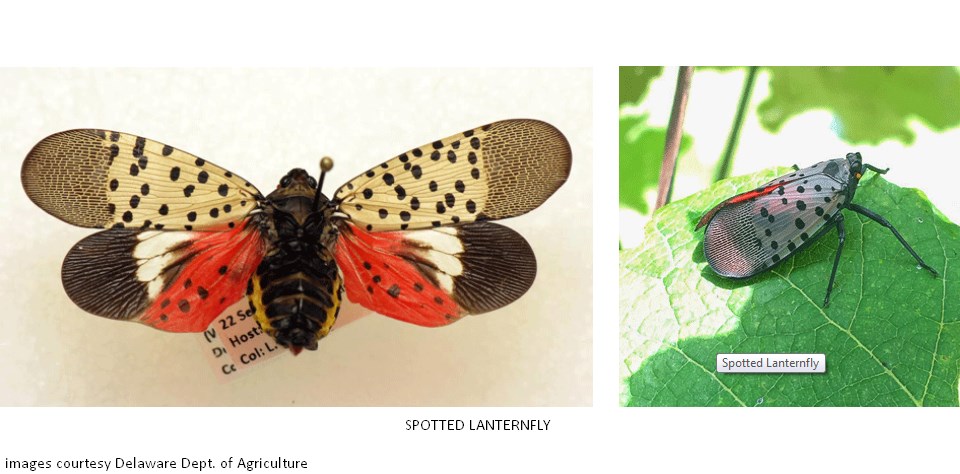Spotted Lanternfly Quarantine Now in All of NCCo

Effective July 1, the Delaware Department of Agriculture (DDA) will quarantine New Castle County in its entirety due to established populations of spotted lanternfly found in Odessa. This is an expansion of the quarantine initially enacted in February 2019 and updated in September 2019.
DDA continues to partner with USDA to conduct surveys and property assessments, while USDA oversees treatment of properties identified with tree of heaven. To date, 4,088 acres have been treated including 20,135 trees encompassing 185 properties above the Chesapeake and Delaware Canal.
Tree of heaven is necessary for the spotted lanternfly to reproduce and eliminating this invasive species helps to decrease the population of spotted lanternfly. This tree is often seen in industrial parks, along highways and railways, and in unmanaged areas or vacant lots.
“Due to the mild winter, we have experienced a high hatch rate of spotted lanternfly nymphs. This is consistent with the reports we are receiving from New Castle County residents who are asking how to get rid of this pest,” said DDA Plant Industries Administrator Jessica Inhof. “The treatment program is focused on properties that have tree of heaven present, but we know from surveying that many homeowners are finding the nymphs on other plants in their landscapes as well. We are encouraging homeowners experiencing outbreaks of this pest to use insecticides labeled for plant-hoppers or leaf-hoppers to kill nymphs and adult spotted lanternfly. If homeowners don’t feel comfortable applying insecticides themselves, they can hire a commercially licensed turf and ornamental pesticide applicator to conduct treatments.”
The spotted lanternfly is a destructive invasive plant hopper that attacks many hosts including trees, shrubs, orchards, grapes, and hops. The insect is detrimental to Delaware’s agricultural industry, forests, and residential areas. Due to quarantines in other states, interstate commerce will be impacted if the pest is transported out of the Delaware quarantine area.
The quarantine can expand if there is reason to believe that the pest has moved to a non-quarantined area. A quarantine means that any material or object that could harbor the pest cannot be moved without taking precautions to prevent the spread. Adults can fly, hop, or drop onto a vehicle – meaning that this pest can easily be transported to new areas where it can create another infestation.
“We are encouraging everyone to help us battle the spotted lanternfly and slow its spread. We have really shifted gears in New Castle County to a capture or destroy mentality. All spotted lanternfly should be destroyed, but if you are below the C&D Canal and find spotted lanternfly we want to know and need a specimen to confirm.” said Katie Bielicki, Delaware Spotted Lanternfly Program Coordinator. “Over the next week or so, residents will see the nymph change in colors to black with red splotches and white dots. Once this happens, the metamorphosis to the adult form is not far off and typically begins by mid-July. It’s a lot easier to treat with insecticide to kill the nymphs now, than it is to kill adults who often will climb into the upper canopies of trees to lay their egg masses.”
Beginning in September, the female spotted lanternfly will lay several egg masses of 30 to 50 eggs wherever it chooses, especially on flat surfaces.
Any person conducting business for a commercial business, a municipality, or a government agency that requires movement of any regulated item within or from the quarantine area must have a permit, available through the DDA spotted lanternfly website. To obtain a permit, a designated individual from an organization must receive training and pass an online test to demonstrate a working knowledge and understanding of the pest and quarantine requirements. Training of other employees, inspection of vehicle and products, and removal of living stages of spotted lanternfly must be completed. The permit demonstrates the individual understands how to identify the pest and can ensure the items transported are not carrying the insect.
To move regulated items, the general public is encouraged to download and print the Delaware Resident Spotted Lanternfly Compliance Checklist indicating that you inspected and know that no living life stage of the spotted lanternfly is present, on regulated articles before moving them. The checklist is available online at https://de.gov/hitchhikerbug. DDA recommends keeping the checklist in the glovebox of each vehicle and dating when specific items on the list are inspected prior to transporting.
Examples of regulated articles include:
- Any living life stage of the spotted lanternfly
- Landscaping, remodeling, or construction materials
- Firewood of any species
- Packing materials (e.g. wood crates, boxes)
- All plants and plant parts including all live and dead trees, perennial and annual plants, and mulch
- Outdoor household articles like RVs, lawnmowers, chairs, grills, tarps, tile, stone, deck boards, and other vehicles not stored indoors.
For more detailed information regarding the quarantine, permitting, treatment, or to report a sighting of spotted lanternfly, visit the Delaware Department of Agriculture’s dedicated spotted lanternfly webpage at https://de.gov/hitchhikerbug or call the dedicated spotted lanternfly hotline at (302) 698-4632. When leaving a message, leave your contact information and, if reporting a sighting, please provide the location of the sighting.


